 1. Starting with the Fish
Young Nile Tilapia fish are warmed by heat radiating
from coils of water connected to a roof-level water tank that
absorbs the sun's energy.
1. Starting with the Fish
Young Nile Tilapia fish are warmed by heat radiating
from coils of water connected to a roof-level water tank that
absorbs the sun's energy.
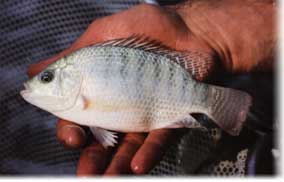 1a. Caring
for Tilapia *
Tilapia eat
duckweed and algea that grow in the nutrient-rich water.
1a. Caring
for Tilapia *
Tilapia eat
duckweed and algea that grow in the nutrient-rich water.
|
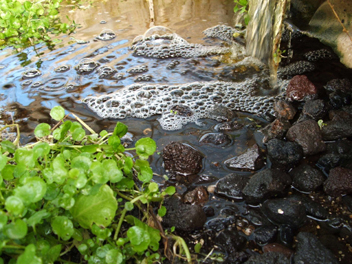 2. Aerobic Biofilter Habitat
The water falling from the plants above onto the rocks
in the fish pond
creates a habitat with a balance of air, moisture
and nutrients for
microbes that cleanse water.
2. Aerobic Biofilter Habitat
The water falling from the plants above onto the rocks
in the fish pond
creates a habitat with a balance of air, moisture
and nutrients for
microbes that cleanse water.
|
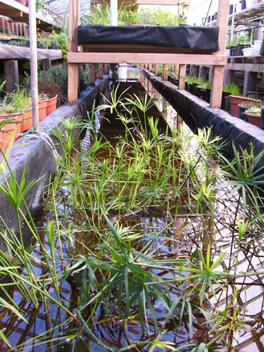 2a. Wetland Biofiltration
Beneficial bacteria thrive on the submerged, oxygen-rich
plant roots of papyrus. The bacteria convert the toxic ammonia
in fish waste to nitrate, used for nutrients by vegetables.
2a. Wetland Biofiltration
Beneficial bacteria thrive on the submerged, oxygen-rich
plant roots of papyrus. The bacteria convert the toxic ammonia
in fish waste to nitrate, used for nutrients by vegetables.
|
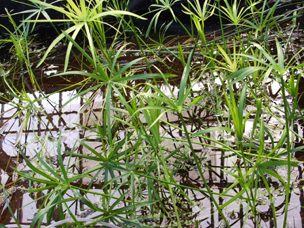 2b. Wetland Plants
Wetland plants have adapted to the anoxic conditions
of marsh depths lacking oxygen by drawing air down from their
stems and leaves into their roots. These oxygen-rich roots are
teeming with aerobic microbes.
2b. Wetland Plants
Wetland plants have adapted to the anoxic conditions
of marsh depths lacking oxygen by drawing air down from their
stems and leaves into their roots. These oxygen-rich roots are
teeming with aerobic microbes.
|
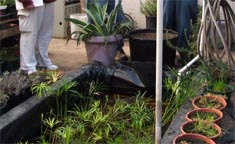 2c. Anerobic Biofilter Habitat
Porous lava rocks lining the pond bottom provide a
home for the teeming anerobic bacteria that transform ammonia
into harmless nitrogen gas that returns safely to the atmosphere.
2c. Anerobic Biofilter Habitat
Porous lava rocks lining the pond bottom provide a
home for the teeming anerobic bacteria that transform ammonia
into harmless nitrogen gas that returns safely to the atmosphere.
|
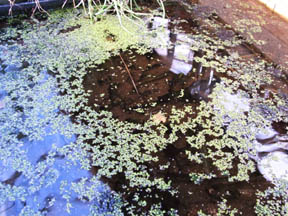 3. Duckweed
floats over the gravel bed. It absorbs the ammonia
and converts it into a protein-rich biomass that easy to digest
by fish. Click on the frog to learn more about duckweed:
3. Duckweed
floats over the gravel bed. It absorbs the ammonia
and converts it into a protein-rich biomass that easy to digest
by fish. Click on the frog to learn more about duckweed:
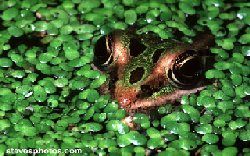
|
 3a. Cultivating Duckweed
Duckweed, equal in protein to commercial fish pellets,
produces more protein than soybeans. When combined with plankon
and algea, duckweed provides a complete nutrient source for Nile
Tilapia, while cleansing the water.
Duckweed Aquaculture
3a. Cultivating Duckweed
Duckweed, equal in protein to commercial fish pellets,
produces more protein than soybeans. When combined with plankon
and algea, duckweed provides a complete nutrient source for Nile
Tilapia, while cleansing the water.
Duckweed Aquaculture
|
 4.
Vermicomposting*
Red earthworms (Eisenia fetida) eat semi-decomposed
foodscraps, yard waste and manures. They can transform dried
fish sludge into vermicompost. Mix in kelp and greensand, if
available, to add valuable trace minerals and grit for earthworms.
4.
Vermicomposting*
Red earthworms (Eisenia fetida) eat semi-decomposed
foodscraps, yard waste and manures. They can transform dried
fish sludge into vermicompost. Mix in kelp and greensand, if
available, to add valuable trace minerals and grit for earthworms.
|
 5. Soil-Media and Irrigation
5. Soil-Media and Irrigation
Vermicompost is mixed with shredded coconut hulls or vermiculite
for a soil media. This mix provides balanced nutrients and air,
and wicks up moisture from the flow of water pumped up from the
fish pond below.
|
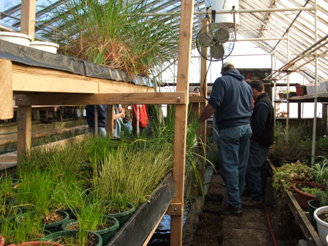 6. Plant Troughs
Almost any vegetable can be grown in the plant trough.
Shallow rooting varieties, ie: watercress, lettuce, salad greens
or basel, do especially well.
6. Plant Troughs
Almost any vegetable can be grown in the plant trough.
Shallow rooting varieties, ie: watercress, lettuce, salad greens
or basel, do especially well.
|
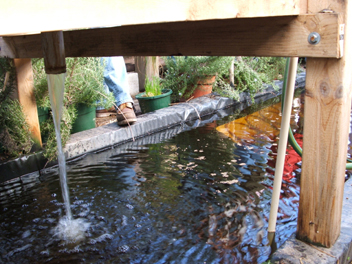 7. Renewed Water
The cleansed water recirculates down into the fish
pond, completing the cycle.
7. Renewed Water
The cleansed water recirculates down into the fish
pond, completing the cycle.
|
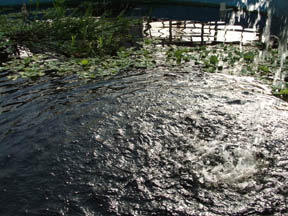 Aquaponic-Pond Ecosystem
Powered by sunlight, enriched by oxygen from the waterfall,
nourished by fish-waste nutrients, the pond is home for a treasure
of microscopic creatures.
Aquaponic-Pond Ecosystem
Powered by sunlight, enriched by oxygen from the waterfall,
nourished by fish-waste nutrients, the pond is home for a treasure
of microscopic creatures.
|
 An 18' pond with nearly 100' of plant troughs.
An 18' pond with nearly 100' of plant troughs.
|
 Three-tiered Aquaponic System
Build your own system for bio-intensive fish-vegetable
garden.
Three-tiered Aquaponic System
Build your own system for bio-intensive fish-vegetable
garden.
|
|
|


















 Bioshelters
Bioshelters Aquatic Microbial Life
Aquatic Microbial Life
 Intervale
Intervale